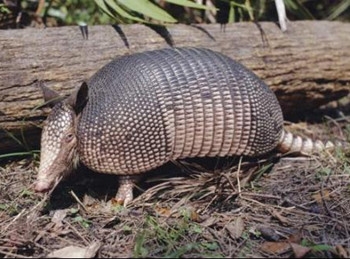(单词翻译:单击)

But the glyptodont wasn't a reptile. So what was it? There is a relative of the glyptodont that’s still alive today. It's the armadillo and it's a mammal, the only mammal with this kind of armor in the whole of North America. It may give us some idea of how an ice age glyptodont might have looked when alive.
但是雕齿兽却并不是爬行动物。那它又属于什么动物呢?如今还存活着一种与雕齿兽存在“血缘关系”的动物。这就是犰狳,犰狳是一种哺乳动物,并且是整个北美唯一拥有这种的“盔甲”哺乳动物。这能让我们想象得出那些冰河时代的雕齿兽活着的时候大概是什么样子。
Armadillos have poor eyesight and rely mostly on their sense of smell. Much of their time is spent nose to the ground in search of food.
犰狳不具备良好的视力,主要依赖其敏锐的嗅觉。他们大部分的时间都在用鼻子探索土地以嗅出食物。
Like the glyptodont, they are covered in a layer of bony scutes. But the armadillo's body armor is surprisingly thin and flexible and doesn't slow its owner down. So what about the glyptodont?
和雕齿兽一样,犰狳的身上也覆盖着一层骨鳞。但是犰狳身上的盔甲却惊人的薄,并且柔韧性很强,犰狳并不会因其减慢速度。那么雕齿兽的盔甲又是什么样呢?
The glyptodont's scute casing was up to 5 centimetres thick and fused into a solid shell. The shell alone is extremely heavy. And the entire animal probably weighed as much as a small car. It had extremely sturdy legs and five toes on each foot to spread its massive weight. The heavy tail probably acted as a counterbalance. So the glyptodont wasn't built for speed, but inside all this body armor, you'd imagine it was well protected. But one fossil skull tells a different story. It suggests the glyptodont's defences weren't impenetrable.
雕齿兽的盔甲骨有5厘米厚,并且是一整块固体的壳。光光整个背壳便十分沉重。雕齿兽整个身体的重量可能相当于一辆小汽车。它的腿部十分健壮,每只脚上的5个脚趾都增加了它的体重。它沉重的尾巴可能作为一个平衡杆。因此雕齿兽并不擅长速度,但是在如此的“盔甲”下面,你可以想象它的身体被保护地如何良好。但是化石的头骨却告诉了我们一个不同的故事——雕齿兽的防御力并不是那么强大。
英文文本来自普特英语,译文属可可原创,仅供学习交流使用,未经许可不得转载.


